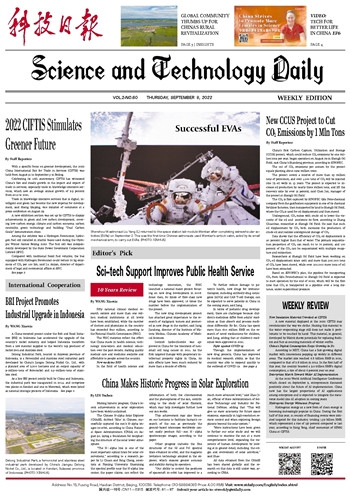
 Academic Journey to Roof of the World
Academic Journey to Roof of the World Global Community Thumbs up for China's Rural Revitalization
Global Community Thumbs up for China's Rural Revitalization 2022 CIFTIS Stimulates Greener Future
2022 CIFTIS Stimulates Greener Future New CCUS Project to Cut CO_2 Emissions by 1 Mln Tons
New CCUS Project to Cut CO_2 Emissions by 1 Mln Tons Sci-tech Support Improves Public Health Service
Sci-tech Support Improves Public Health Service BRI Project Promotes Industrial Upgrade in Indonesia
BRI Project Promotes Industrial Upgrade in Indonesia WEEKLY REVIEW
WEEKLY REVIEW China Makes Historic Progress in Solar Exploration
China Makes Historic Progress in Solar Exploration WECHAT ACCOUNT
WECHAT ACCOUNT E-PAPER
E-PAPER
Making historic progress, China's recent achievements in solar exploration have been widely acclaimed.
The Chinese H-alpha Solar Explorer (CHASE), dubbed 'Xihe' in Chinese, successfully captured the sun's H-alpha images in-orbit, according to China National Space Administration (CNSA) on August 30, laying a foundation for deciphering the structure of the solar lower atmosphere.
"The H -alpha line is one of the most important optical lines for solar observations," according to a research paper by Li Chuan and Fang Cheng, scientists at Nanjing University. Examining the spectral profile near the H-alpha line center, the paper claims, can reflect the information of both the chromosomes and the photospheres of the sun, contributing to the study of solar filament, which may help investigate further how our sun works.
This achievement may also broaden our horizons to facilitate human's research of the sun as previously the ground-based telescopes worldwide cannot easily produce full -sun H -alpha spectroscopic images, according to the paper.
Other progress includes the fine structures of the SiΙ and FeΙ spectral lines obtained in-orbit, and the magnetic levitation technology adopted in the explorer, which ensures greater accuracy and stability during its operation.
"Our ability to control the positions of spacecraft in-orbit has improved to a much more advanced level," said Zhao Jian, official of State Administration of Science Technology and Industry for National Defense, adding that "This will give us more autonomy for future space missions, especially in high-resolution remote control and when exploring foreign planets beyond the solar system."
"More instructions have been given to further our solar study and we will continue to examine the sun at a more comprehensive level, expanding the trajectory of human development by looking at in greater detail, including the origin and evolvement of solar activities," said Zhao.
All data obtained from the CHASE has been shared globally and the research on this data is still under way, according to CNSA.

 Next
Next



